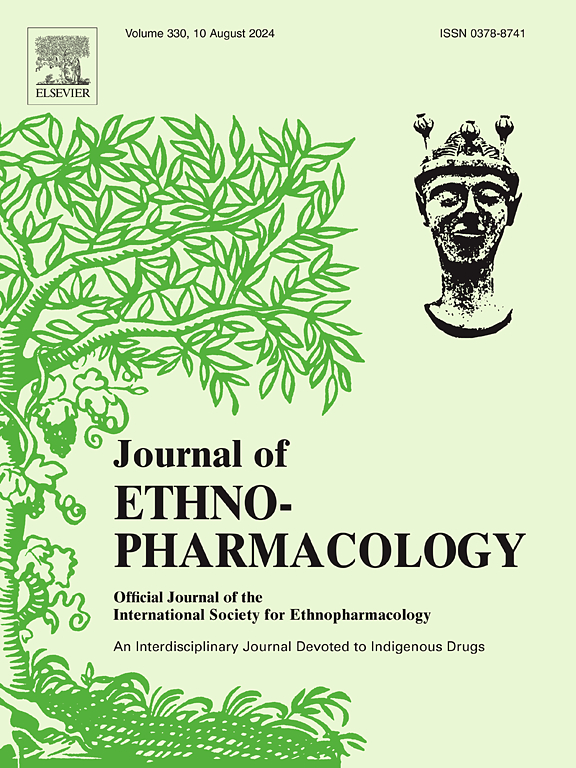印度药用植物资源库:认证、质量控制和保护的统一协调方法。
IF 5.4
2区 医学
Q1 CHEMISTRY, MEDICINAL
引用次数: 0
摘要
民族药理学相关性:真正的植物鉴定、质量问题和保护是目前在传统系统中使用的印度药用植物物种贸易中的差距。印度阿尤什省执行原料库(RDR)作为解决这些问题的关键战略。研究目的:本综述提出了一个统一的植物库概念,作为管理阿育吠陀、悉达和乌纳尼(ASU)系统中使用的草药原料的系统方法。资料:参考电子数据库、药典、报告和书籍来确定相关文献。结果:本综述系统地组织了植物资源库的科学文献,内容简明、结构化,易于获取和理解。它提议将AYUSH RDR联网,特别关注国家原料药储存库(NRDR)与现有草药储存库,以探索AYUSH领域的未来机会。该研究对原料药进行了分类,分析了它们的特征,并对植物参考物质(BRS)的开发方法进行了分类。讨论了NRDR在BRS、草药贸易协调和植物研究方面的意义。本文提出了一个虚拟存储库的原理图设计,以增强用户的可访问性。结论:本研究为研究人员、利益相关者和从业者解决印度药用植物物种问题提供了指导。它将提高对ASU药品收集中心、认证设施、BRS的认识,并提出可持续性计划和改进RDR的建议。这项研究为它们进一步扩展到印度其他地理区域提供了榜样。本文章由计算机程序翻译,如有差异,请以英文原文为准。

Botanical repositories for Indian medicinal plants: A unified harmonisation approach to authentication, quality control, and conservation
Ethnopharmacological relevance
True botanical identity, quality issues, and conservation are the current gaps in the trade of Indian medicinal plant species used in traditional systems. The Ministry of AYUSH, India executed raw drug repositories (RDR) as a key strategy to solve such issues.
Aim of the study:This review presents a unified concept of botanical repositories as a systematic approach to managing herbal raw drugs used in the Ayurveda, Siddha, and Unani (ASU) systems.
Material
Electronic databases, pharmacopoeias, reports, and books were referred to identify relevant literature.
Results
The review systematically organizes scientific literature of botanical repositories in a concise and structured manner, making it accessible and comprehensible. It proposed a networking of the AYUSH RDR with a special focus on the National Raw Drug Repository (NRDR) with existing herbal repositories to explore future opportunities in the AYUSH domain. The study categorised raw drugs, their profiling, and the methodology for development of botanical reference substances (BRS). It discussed the significance of NRDR in terms of BRS, harmonisation of herbal trade, and botanical research. This work proposed a schematic design for a virtual repository to enhance user accessibility.
Conclusion
The study serves as a guide for researchers, stakeholders, and practitioners to resolve issues on Indian medicinal plant species. It will raise awareness about the collection center of ASU drugs, authentication facilities, BRS, and proposed a sustainability plan & recommendations for betterment of RDR. The study serves as a role model for their further extension into other Indian geographical zones.
求助全文
通过发布文献求助,成功后即可免费获取论文全文。
去求助
来源期刊

Journal of ethnopharmacology
医学-全科医学与补充医学
CiteScore
10.30
自引率
5.60%
发文量
967
审稿时长
77 days
期刊介绍:
The Journal of Ethnopharmacology is dedicated to the exchange of information and understandings about people''s use of plants, fungi, animals, microorganisms and minerals and their biological and pharmacological effects based on the principles established through international conventions. Early people confronted with illness and disease, discovered a wealth of useful therapeutic agents in the plant and animal kingdoms. The empirical knowledge of these medicinal substances and their toxic potential was passed on by oral tradition and sometimes recorded in herbals and other texts on materia medica. Many valuable drugs of today (e.g., atropine, ephedrine, tubocurarine, digoxin, reserpine) came into use through the study of indigenous remedies. Chemists continue to use plant-derived drugs (e.g., morphine, taxol, physostigmine, quinidine, emetine) as prototypes in their attempts to develop more effective and less toxic medicinals.
 求助内容:
求助内容: 应助结果提醒方式:
应助结果提醒方式:


